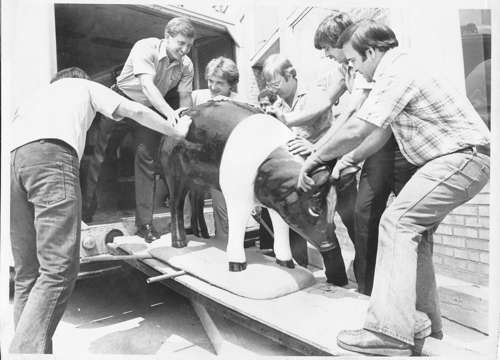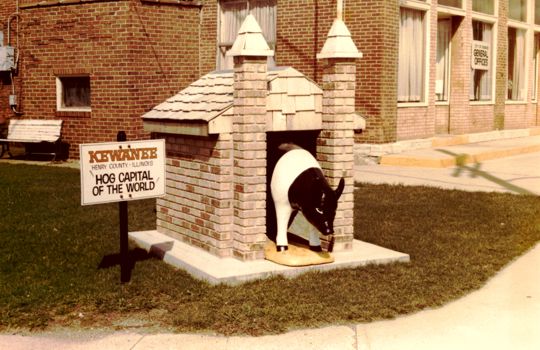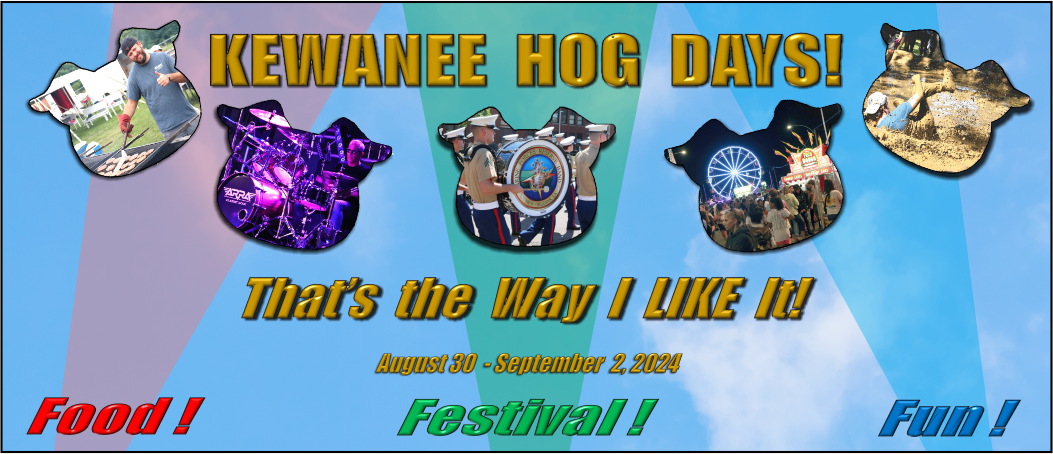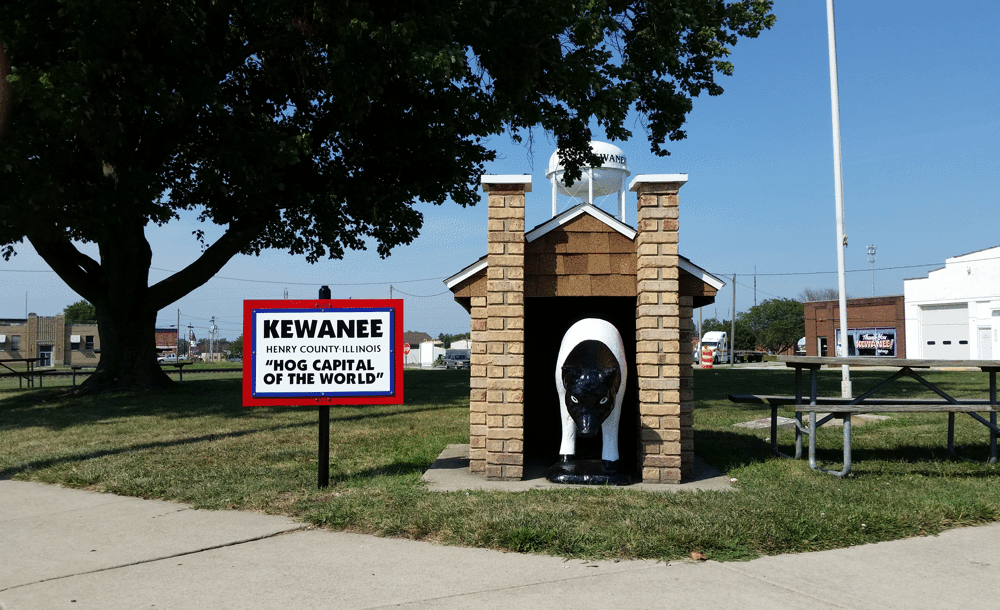| Where did the concrete hog and its castle
come from located in Berrien Park at Tremont and Third Streets in
downtown Kewanee? And how did it become a focal year-round reminder
of Hog Days? The following account is provided courtesy of Dave
Clarke and the Kewanee Star Courier and originally appeared in
Dave's 'Around Town' column on Saturday, August 21, 2015.
KEWANEE The concrete hog in a small, brick 'castle' in the
southwest corner of the green space (now officially called Berrien
Park) at Third and Tremont streets is a local fixture photographed
by countless visitors to prove they were in the Hog Capital of the
World. But where did the city's symbolic swine come from? Who put it
there and who paid for it?
Several members of the Hog Capital of the World Festival Committee
recently cleaned years of accumulated debris out of the small brick
structure and gave a needed coat of new paint to the pig, which
stands in the doorway watching people come and go from Cerno's
across the street. Breedlove's made a new sign which has been
mounted on a new board and stands next to the display telling
everyone they are in Kewanee, "Hog Capital of the World." Festival
committee member Bill Scott is building new turrets for the towers
on both sides of the door, which came off somehow over the years.
Larry Flannery, committee co-chairman, said as they worked, someone
commented that the city should be sprucing up the pig because they
own the display which was in front of city hall when it stood on the
site. A few days later, Flannery happened to be at city hall and
asked city manager Kip Spear who "technically and legally" owns the
pig and palace on the green space, which is still city property. Not
just for upkeep, but in these days of lawsuits, it's good to know
who owns what in case, heaven forbid, something unfortunate would
happen. Flannery explained that over the years volunteers from the
festival committee have taken care of maintaining the pig, but who
actually owns it? Spear said he wasn't sure but thought it belonged
to the festival committee. Both then wondered when the 'castle' was
built and who put it there. Spear and even "oldtimers" on the
committee remember it as just always being there, as do most of the
rest of us. "Around town" was then asked to investigate. Flannery
said if the origin of the display can be found, they can put the
information on their website and in their files where it can be
found by anyone searching in the future.
I remember a concrete hog sitting between the front doors of the
former city hall painted black with the white band of the Hampshire
breed. I can remember that one night vandals broke it loose from its
pedestal with a log chain and dragged it down the street. That has
become one of Kewanee's more popular legends. I can remember when
the "castle" was NOT where it is today but as for when each pig was
put in place and by whom, I draw a blank.
 
I went to the Kewanee Historical Society museum where I had e-mailed
my questions earlier. Pat Lock had gone through their scrapbooks on
the Hog Festival and came up with some answers. The news stories
indicated a 900-pound concrete hog "donated to the city last year by
the Hog Festival Committee" was yanked off its feet from in front of
City Hall by vandals and dragged down the street behind a pickup in
January of 1981. That indicates the statue was put in place sometime
in 1980. Two young men were later arrested and charged with damage
to city property, which indicates that at least at the time, the
city considered the cement squealer theirs.
The next story was from Friday, Aug. 31, 1984, and included a photo
of the pig in the palace with a man identified as Jerry Blodgett
"applying the finishing touches" of paint to the eyes of the pig in
its new "castle," which it stated was built by volunteer labor and
donated materials, not by the city. Apparently a second concrete pig
had been acquired since 1981. This is also when the pig lost its
ears. According to the 1984 story, workmen, in a rush with Hog Days
just days away, lifted the statue from the city hall step with a
strap and crane to move it into place in the partially completed
"castle" before covering it with the roof. According to the account,
the cement swine slipped and fell headfirst into the side of the
under-construction brick 'castle.' This created the second most
popular legend about the statue the backwards ears. The collision
sheared off the pig s pointers and they desperately sought a way to
replace them before the weekend celebration. Apparently because of
the small size, they could not find a concrete form that would work
so someone suggested fiberglass body putty. It was done in haste
and, as local pork producers pointed out, by some well-meaning
person who didn't know pigs. Instead of pointing forward, they
pointed back. People said the pig looked like it had been scared, or
more like a dog than a hog. An article about "King Hog's"
unfortunate life appeared a few days after Hog Days in the Peoria
Journal-Star, and said there had not been time to correct the
mistake before the festival but that the ears would be corrected
afterward.
It took several years, while people familiar with hogs snickered at
Kewanee's symbol, but someone finally switched the ears back the way
they should be. According to the Journal-Star story, the Hog
Festival Committee bought the first concrete hog four years earlier,
which would be 1980, and placed it outside city hall. It appears the
"steepled palace" was built as a "picturesque and safe surrounding
because the symbol has had a rough life," alluding to the
hog-napping of the first statue just months after it was put in
place. It was apparently felt the structure would protect the statue
from the elements and attacks.
With the dates narrowed down by the historical society, Flannery
went to the minutes of monthly committee meetings and in the Aug.
11, 1980 record he found this entry by then-secretary Karen Ording:
"The Garden Center in Galesburg has a 900-pound cement hog painted
like a Hampshire, for which they are asking $300. The Chamber of
Commerce has asked us for suggestions on how it could be used in
Kewanee. Committee suggestions were to put it in Veterans Park or
some other park in town, or possibly in front of City Hall." So, it
looks like the idea for a concrete statue of a hog originated with
the Chamber of Commerce. Once it was decided to acquire the hog, the
Chamber apparently approached the city about locating it between the
front doors of the city offices. Does that mean the Chamber is
ultimately responsible for at least the hog?
Flannery then went to the 1984 file and in the minutes of the Aug.
28 meeting, found a discussion on "whether or not to donate two
little pigs for the pig castle." A plaque would the hung to
acknowledge this," the minutes read. The motion carried and there is
mention of adding piglets in the Aug. 26 Star Courier account, but
nothing was apparently ever done. As far as when the replacement pig
was acquired and by whom, that is not known. It had to be between
the vandalism in 1981 and when the second pig was moved from city
hall to the new castle. As to who paid for it, the newspaper stories
indicate the two young men charged with destroying the first pig
volunteered to pay for a new one. Now that we know the original
price and where they got it, the cost may have been included by the
court in restitution when the vandals were sentenced. It's ironic to
think that the pig that now stands in the castle may have been paid
for by the two guys who dragged its predecessor down the street.
The original hog was extensively damaged. A newspaper photo shows it
on its side in the city street department yard where it was dumped
after being found abandoned on Franklin Street. All four feet had
been broken off and the torso was chipped and scratched. I'm not
sure how it got there, but the statue was later seen in a flower bed
at the farm home of John and Irene Spiegel, longtime festival
committee members who apparently "rescued" it from the dump. After
the Spiegels both passed away and the property was sold, the pig was
"rescued" again by the late Arlene McNaught, another longtime
committee member and collector of pig memorabilia. She had the
statue placed in the front yard of her Kewanee home where it
remained until her death. Vera Yelm and her husband bought two hog
statues from McNaught's estate sale following Arlene's passing. The
one from in front of McNaught's house is now in the Yelm's backyard
on Edwards St. The "banged up one" from McNaught's backyard they
purchased for $1. This is thought to be the original damaged and
hoofless concrete porker that was dragged from the front steps of
City Hall in 1981. It is now being stored by a friend of the Yelms.
|



